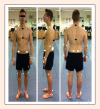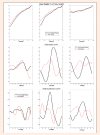What is the Safest Sprint Starting Position for American Football Players?
- PMID: 24790500
- PMCID: PMC3990900
What is the Safest Sprint Starting Position for American Football Players?
Abstract
The main objective of this study was to perform a biomechanical analysis of three different sprint start patterns to determine the safest position in term of neck injury and Sport-Related Concussion (SRC). The second objective was to collect data on the learning process effect between football players and non-players. Three different sprint initial positions adopted by football players were studied (i.e., 4-, 3- and 2-point positions). Twenty five young healthy males, including 12 football players, participated to this study. A stereophotogrammetric system (i.e., Vicon) was used to record motion patterns and body segments positions. Various measurements related to head and trunk orientation, and player field-of-view were obtained (e.g., head height, trunk bending, time to reach upright position, head speed (vertical direction) and body speed (horizontal direction)). Learning process was found to have no influence on studied parameters. Head redress is also delayed when adopting a 4-point position leading to a reduce field-of-view during the start and increasing therefore the probability of collision. Concerning the three different positions, the 4-point position seems to be the more dangerous because leading to higher kinetic energy than the 2- and 3-point start positions. This study proposes a first biomechanical approach to understand risk/benefit balance for athletes for those three different start positions. Results suggested that the 4-point position is the most risky for football players. Key pointsMotion analysis and biomechanical analysis of the initial start position of the sprint could be used to increase the safety of the football players.Analysis of kinematic and trajectory of the head and the time to reach the upright position could be used to determine whether or not a player can return to play after concussion.A balance needs to be found between player's safety (2-point start) and speed (4-point start).
Keywords: Sports; biomechanics; brain concussion; sports medicine.
Figures




References
-
- Altaf F., Mannan K., Bharania P., Sewell M.D., Di Mascio L., Sinisi M. (2012) Severe brachial plexus injuries in rugby, Injury 43 (3), 272-273 - PubMed
-
- Brigham C.D., Warren R. (2003) Head to head on spear tackler's spine: criteria and implications for return to play. The Journal of Bone and Joint Surgery American 85-A(2), 381-382; author reply 382-3833 - PubMed
LinkOut - more resources
Full Text Sources
Miscellaneous
